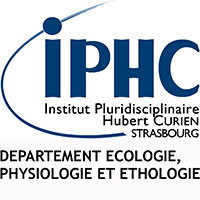Conservation biology of the European hamster (Cricetus cricetus)
Conservation du Grand hamster (Cricetus cricetus)
Résumé
The European hamster (Cricetus cricetus) is one of the most endangered mammal in Europe. In France, less
than 800 individuals are currently inhabiting farmlands of the ‘Grand-Est’ Region. However, despite the
specific actions undertaken since 2000 in favor of hamsters’ conservation, the French population is still
highly threatened. My thesis is part of the project ALISTER (Life + Biodiversity program funded by the
European Union), which aims at testing the relevance (at the regional level) of some actions previously
identified as potentially favorable to the species. Nonetheless, there is still a huge gap in understanding the
underlying mechanisms that could affect hamsters’ fitness. Specifically, this work therefore aimed at
bringing scientific knowledge regarding hamsters’ eco-physiology and behavioral ecology, in order to
improve conservation strategies of this targeted species. This has been done throughout two main
approaches:
1. Investigating for the nutritional effects of crops on the fitness of the hamster and finding which crops, of
economic interest, are the most favorable for the hamster in terms of nutritional inputs. In that aim, the
effects of several crops on the hibernation and the reproductive success of captive and semi-captive
hamsters have been investigated. The main results highlight that elevated maize consumption is severely
reducing hamsters’ reproduction because of a major deficiency in vitamin B3. This deficiency appears
extremely difficult to compensate with other food items, and only the association with sunflower allow
hamsters to have a proper hibernation and first reproduction under captive conditions. More broadly,
results highlight the negative effects of wheat and maize monoculture on the fitness of this species and
pinpoint that the implementation of crop associations such as wheat-soybean and maize-sunflower need
to be implemented in the Alsace, as a conservation measure for this species.
2. Evaluating the antipredatory behavior of the European hamster and developing an anti-predation tube
(APT) that will serve to upgrade wildlife underpasses in the Alsace and ultimately allow to reconnect wild
populations. The tests have been carried out under controlled and semi-captive conditions and the main
results reveal that hamsters display an offensive strategy (e.g. mobbing, threatening and attacking the
predator) when facing cats’ urine or a real predator (i.e. the European ferret). In these context, the efficiency
of our anti-predation device has been validated since it allowed hamster to take refuge when facing an
actual predation risk. The APT will now be implemented in wildlife underpasses in the Alsace, whereas its
effectiveness will now be evaluated via a comprehensive video monitoring under natural conditions. The
results obtained regarding the antipredatory behavior of this species bring new perspective avenues that
could be applied to the hamster conservation.
Le Grand hamster (Cricetus cricetus), l’un des mammifères les plus menacés d’Europe, est en voie d’extinction
en France. Toutefois, nous manquons d’information sur les causes de son déclin et sur comment améliorer sa
conservation. Durant ma thèse, je me suis intéressée à l’effet des cultures sur la reproduction du hamster. Les
principaux résultats indiquent qu’une consommation importante de maïs conduit à une diminution drastique
du succès reproducteur en raison d’une carence en vitamine B3. Une autre étude démontre que des
associations de cultures (blé-soja ou maïs-tournesol) sont favorables au hamster et devraient être mises en
place en Alsace. En parallèle, j’ai développé un tube anti-prédation (TAP) pour améliorer les passages à faune
et reconnecter les populations sauvages. Des tests comportementaux ont révélé que les hamsters présentent
des comportements audacieux face au prédateur, mais utilisent tout de même le TAP comme refuge, validant
sa fonction anti-prédation. Le TAP sera maintenant mis en place dans plusieurs passages à faune en Alsace. Les
résultats de cette thèse vont maintenant bénéficier à la conservation du hamster en France et en Europe.

